How the Mars Curiosity Rover Captured a Unique Portrait of Earth from 140 Million Miles Away
![]()
The Mars Curiosity rover landed inside the Gale crater on Mars on August 6th, 2012. In the 12 years since, the rover has seen a lot of amazing things on Mars and taken thousands of photos, many unlike anything ever seen before. One such unique photo is the first-ever photo of Earth and the Martian moon Phobos as seen from Mars.
PetaPixel chatted with Mark Lemmon, a longtime Mars Curiosity team member and astronomer at the Space Science Institute, about the new image, learning much more about how the team captured the new images and what the groundbreaking photo means for humanity’s exploration of space at large.
The images were captured using Curiosity’s Mast Camera, also known as Mastcam. This color camera typically captures panoramic photos and videos of the Red Planet’s surface and atmospheric features. It is a 1.9-megapixel camera, meaning it captures 1,600 x 1,200-pixel images. However, the team frequently combines multiple frames into a larger composite or panorama, which can help expand the effective resolution of the Mastcam. For example, in 2022, PetaPixel wrote about Mastcam capturing 133 images to create an expansive panorama that showed evidence of past climate change on Mars.
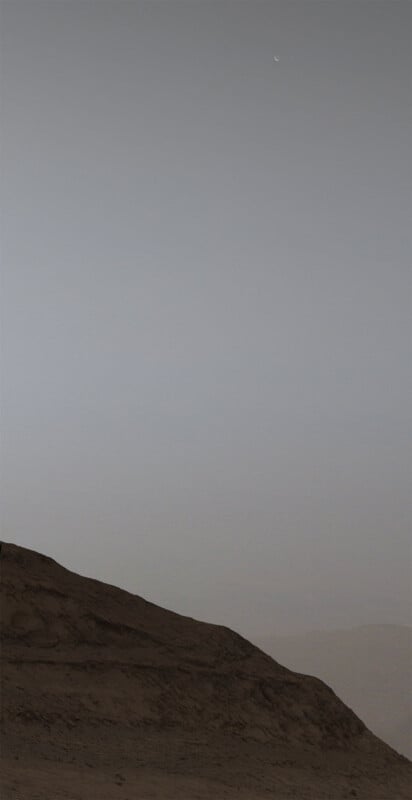
As Lemmon explains, Mastcam has two cameras, a 34mm one and a 100mm one. While the 100mm camera can see more distant objects, it is also more susceptible to motion blur.
“Mastcam is on the rover primarily as a landscape camera to document the geology. It mostly takes color pictures, but it has a filter wheel for multispectral imaging to help assess composition and solar imaging,” Lemmon says.
“The last is part of my thing (atmospheric science is my day job, and I moonlight as an astronomer). Images of the Sun are taken to measure the dust content of the atmosphere as one part of the meteorology campaign, and eclipse/transit videos help to measure the orbital evolution of the moons. After one of the filter wheels failed last year, both cameras have been left in the clear position for color imaging.”
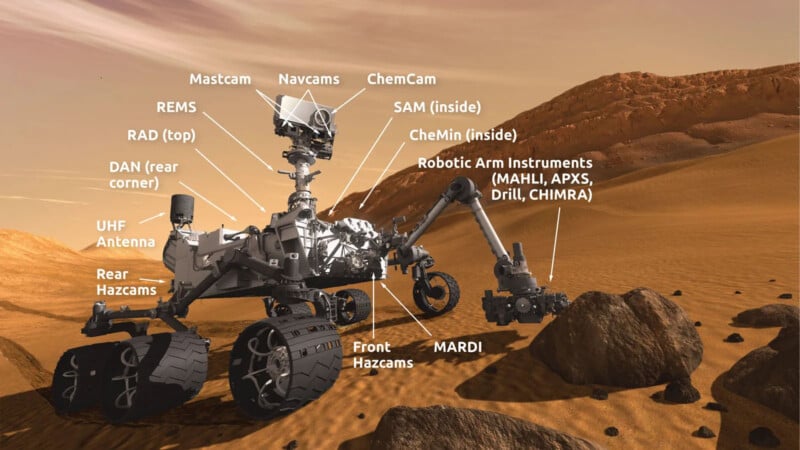
For the new composite image showing Phobos and Earth, Lemmon says the Mastcam sequence started 93 seconds before Phobos passed Earth.
“The cameras were aimed at Earth and took five images at 0.75 seconds each, which was chosen to control motion blur for the 100mm camera,” Lemmon explains. “The middle image of that set was the anchor for the inset, with Earth and Phobos closest to each other.”
The Mastcam has f/10 lenses, so as Lemmon notes, the optics aren’t what astrophotographers on Earth would traditionally use for low-light imaging.
The composite was “a simple version of an astrophotography stacking technique with a slight twist,” Lemmon says, as he and the team worked to stack images to get the cleanest image possible.
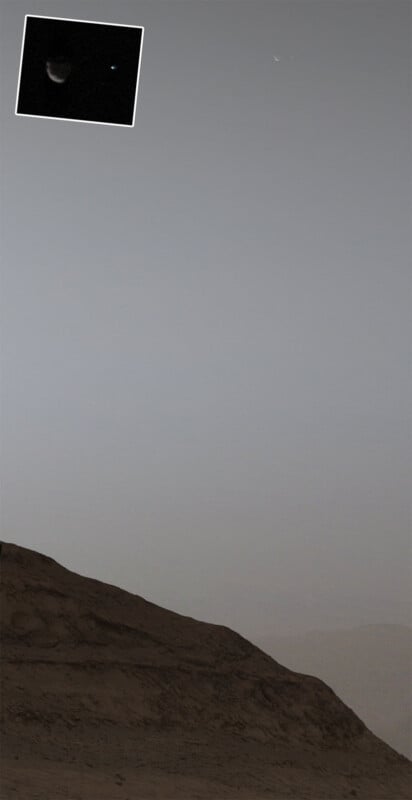
The camera then started doing a two-by-five image mosaic, “snaking downward to the horizon,” of 10-second exposures. Lemmon worried the sky would be too dark given that the images were captured after sunset and following a dust storm, but the final result worked well after corrections.
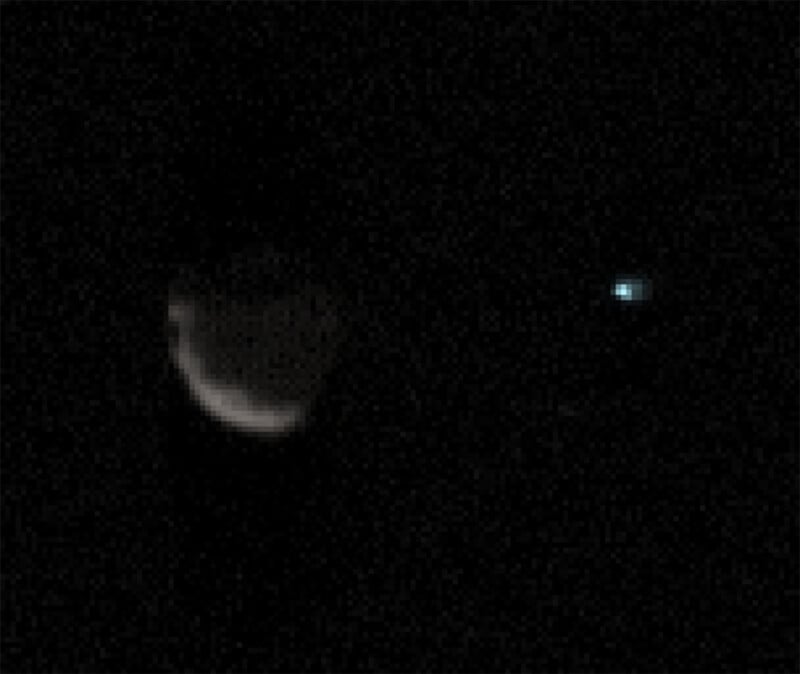
The final composite includes images shot during daylight to add more foreground detail. Still, Lemmon explains that the resulting image is “not far from how it would have been perceived” by a person standing next to Curiosity on Mars as Earth and Phobos passed by.
“Our dynamic range and ability to adapt to light-level variations go beyond print and typical monitor capabilities,” Lemmon says. “Earth would have been the ‘first star’ seen in the diminishing twilight and as bright as the brightest stars we see here [on Earth]. I’m sure a person viewing that scene would have also seen our Moon, just below and to the left of Earth, although it wasn’t bright enough with the short exposures and the sky background.”
Another challenge Lemmon and the rest of the team face is gradual damage to the Mastcam’s image sensors. Having been on Mars for a dozen years, the rover has been exposed to constant radiation levels similar to a U2 spy plane’s flight level. While radiation strikes on the detector are “mostly harmless,” sometimes they cause damage.
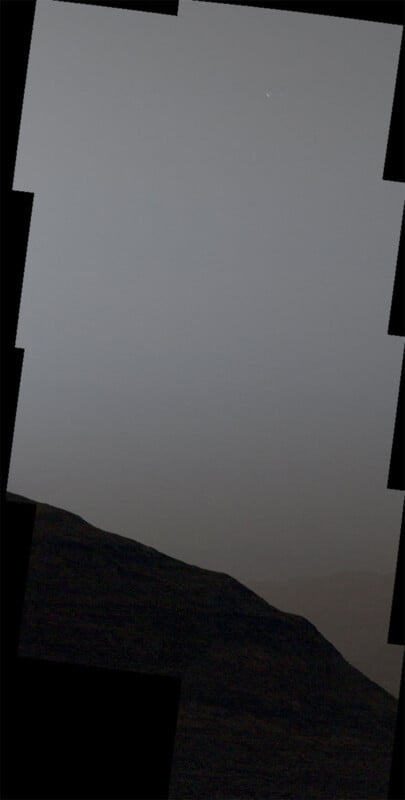
“Occasional strikes cause damage, generally seen as a significant elevation in a pixel’s dark current — a signal seen in the pixel even without light. It has changed dramatically since the camera was in the lab. It has even changed since the middle of last year, the last time we could use the solar filters to get a ‘dark’ image in the daytime when the camera is warm. For typical exposures of several milliseconds, this is no problem. Even for most astronomical imaging, it is not a problem since the moons and stars move and the hot pixels do not. Long-exposure landscape images were a challenge,” says Lemmon.
A Spectacular Photo Months in the Making
The idea for the image was “several months old,” but the actual planning and execution stages came together very quickly.
“On August 29th, I looked for a chance, having noted that was a time when Earth would be an evening star. I accidentally found Earth near Deimos when I checked what the sky would be like for an arbitrary night. Deimos is small, even when not a thin crescent, so I looked for Phobos and found that the closest night-time approach of the year was September 5th,” Lemmon explains.
He and a few camera uplink leads began planning on August 30th after receiving the go-ahead from the Curiosity project scientist. The Curiosity team planned the September 5th activities on September 2nd, and the rover would, fortunately, be finishing an activity right about when it would be needed to capture the required photos.
“The team was very supportive,” Lemmon adds.
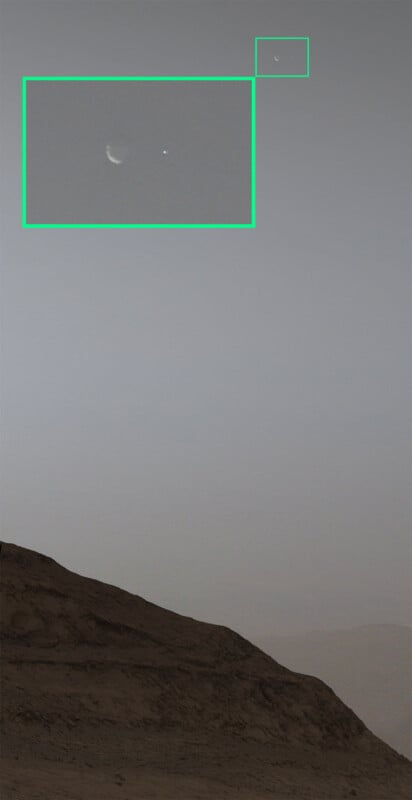
About 90 minutes before the image sequence capture was planned to start, Lemmon was walking his dog before sunrise in Texas and looked up to see Mars in the night sky, knowing that Curiosity would soon be capturing the planned photos.
Once image capture began, the photos made it to Earth quickly. Lemmon was working on a draft of the composite later that day, although finalizing the image took another week or so. Although the September 5th plan worked out exceptionally well, Lemmon says there were other options.
“We had backup options: five days later with even darker conditions, and five days after under much brighter skies when the objects may have been hard to see. I think we got the best of the opportunities by far.”
Inspired By a Legendary Space Photo
Lemmon was inspired by one of the most iconic space images ever captured, 1990’s Pale Blue Dot. The image captured on February 14th, 1990, by NASA’s Voyager 1, shows Earth from 3.7 billion miles (six billion kilometers) away.
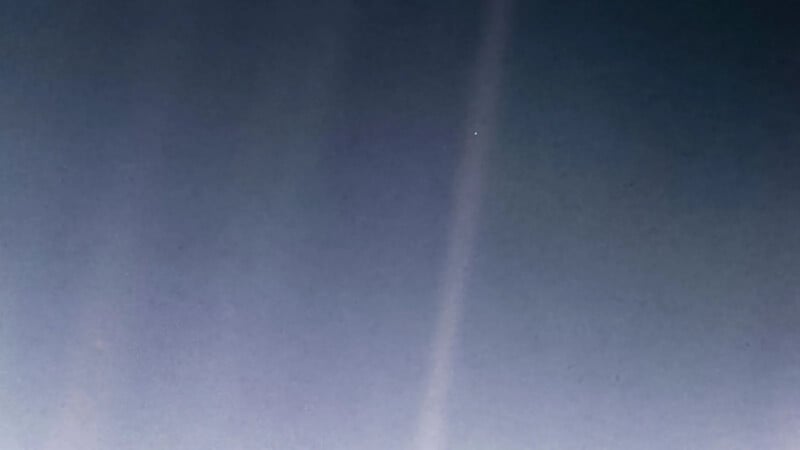
That image shows Earth so small in the frame, but as the late Carl Sagan, who did as much to inspire love and wonder of space as anyone in history, said: “Look again at that dot. That’s here. That’s home. That’s us.”
“I was inspired by the Pale Blue Dot image when it came out, and Carl Sagan’s thoughts on it resonated. As we go out and explore, it is natural and imperative to look back occasionally,” Lemmon says.
While he admits that images like this don’t “advance our understanding of Mars’ history,” it is essential to continue to contextualize the mission. “First and foremost, we are exploring,” he says.
“And, as far as I can tell, few people can look at an image like this and — understanding what the little blue speck is — not get some sense of the vastness of the universe and the smallness of our place in it. An image of the Martian sky, with the ridge in front and Earth above, would have been enough. Having Phobos in frame with Earth, dwarfing it, adds another layer.”
As Lemmon explains, at first glance, the image may seem bland. However, when the viewer looks closer, it becomes apparent that it’s an “alien” landscape with an alien moon and Earth.
“I think it becomes a very special image — its power is not in the pixels but in the viewer’s ability to imagine that speck is us.”
Image credits: NASA/JPL-Caltech/MSSS